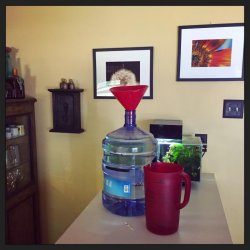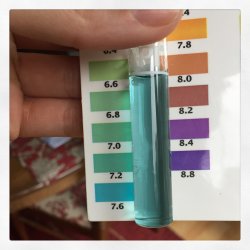thrujenseyes
Fish Herder
Oh boy..
I just got done filling up my 5 gallon water jug with well water:

No worries though...I came here first before making any more moves.
So thanks for that Steven (everytime I type your name I think of Jim Carrey in Cable Guy and how he says Tthhhhteeeeeven) anyway, thank you and I look forward to whatever else it was that you will come back and add to this!
Byron...
I was trying so hard to wrap my brain around the mathematics of your description of how you arrive at the ppm and such and it wasn't working but that was last night before bed so I'll try with a fresher brain now. I had to google dGH as I thought it was another type of hardness that I'd yet to learn about but it's a measurement? A degree? I'll try to read up on that and see if I can figure it out. Oh and yes aragonite is what I meant.
Mark Z... that's great info about Aquarium Center! I never go to their website because it's so old and outdated and just well...terrible. And it's not mobile friendly. I had no idea they announced new arrivals but that's very cool! Probably something I shouldn't look at until I get my water figured out though...to avoid temptation!
So...I'm following most of everything that's been said (except the mathematics of the hardness readings).
I understand now that I can't keep a higher ph because of my KH which is zero and it's zero because that's what my source water from my well is. And because it has zero buffering capabilities even though I can raise the ph with crushed coral it will continually fall unless I leave something in my tank to keep it steady.....?
I still don't know what water I should be using and which way I will go with future stocking.... Soft or Hard water fish.
Right now I need to keep my remaining endlers happy and healthy...so I will use the RO (maybe add flourish comprehensive) I have left and add crushed coral to my tank.
I bought the little mesh media bags and have one all ready to go into my filter.
Question: I keep my water for water changes in these big 5 gallon jug like you see in this picture. Should I add my crushed coral in a bag to the jug so it's safer going into the tank when I do water changes? Or will it be too concentrated because sometimes the water sits for weeks in there?
I just got done filling up my 5 gallon water jug with well water:

No worries though...I came here first before making any more moves.
So thanks for that Steven (everytime I type your name I think of Jim Carrey in Cable Guy and how he says Tthhhhteeeeeven) anyway, thank you and I look forward to whatever else it was that you will come back and add to this!
Byron...
I was trying so hard to wrap my brain around the mathematics of your description of how you arrive at the ppm and such and it wasn't working but that was last night before bed so I'll try with a fresher brain now. I had to google dGH as I thought it was another type of hardness that I'd yet to learn about but it's a measurement? A degree? I'll try to read up on that and see if I can figure it out. Oh and yes aragonite is what I meant.
Mark Z... that's great info about Aquarium Center! I never go to their website because it's so old and outdated and just well...terrible. And it's not mobile friendly. I had no idea they announced new arrivals but that's very cool! Probably something I shouldn't look at until I get my water figured out though...to avoid temptation!
So...I'm following most of everything that's been said (except the mathematics of the hardness readings).
I understand now that I can't keep a higher ph because of my KH which is zero and it's zero because that's what my source water from my well is. And because it has zero buffering capabilities even though I can raise the ph with crushed coral it will continually fall unless I leave something in my tank to keep it steady.....?
I still don't know what water I should be using and which way I will go with future stocking.... Soft or Hard water fish.
Right now I need to keep my remaining endlers happy and healthy...so I will use the RO (maybe add flourish comprehensive) I have left and add crushed coral to my tank.
I bought the little mesh media bags and have one all ready to go into my filter.
Question: I keep my water for water changes in these big 5 gallon jug like you see in this picture. Should I add my crushed coral in a bag to the jug so it's safer going into the tank when I do water changes? Or will it be too concentrated because sometimes the water sits for weeks in there?


 /care.endlers1.com
/care.endlers1.com